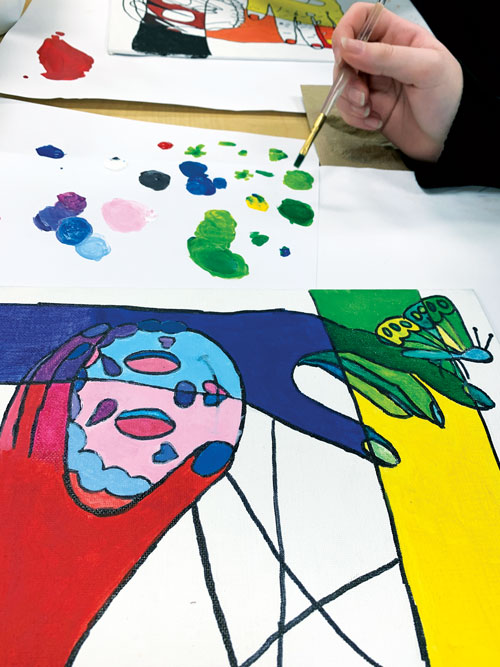 |
 |
| Top: J.T., anti-color wheel composition. Bottom: A painting in progress. Students used acrylics, oil pastels, or watercolors. |
Instead, I incorporate these concepts into actual lessons that always include student expression. Because it’s not “art” without expression, is it?
If I want to explore shading forms, I have students create a still life that includes some of these forms. If I want students to learn about the color wheel, I create an assignment that forces them to mix colors, like the Anti-Color Wheel project.
The Anti-Color Wheel
The framework for this project (and many projects) starts with a list. Students brainstorm and write nine things they feel are truly important to them, then they draw symbols for each item. I have them look at a variety of icons and emojis so they get the idea that these symbols should be simple, bold, and direct.
For this exploration, I have students trace their hands holding four different symbols and overlap their images. Students start with a sketch first, then create their final work on canvas. Each overlap creates a new space that can be colored in. If you decide to do three hands instead of four, you could limit students to primary colors. I use four hands so that one can be solid black and students can explore tints, tones, and shades. Students who finish early can add patterns with paint pens, similar to the work of Brazilian artist Romero Britto.
Adaptations
This exploration could be done with other subjects, including:
- overlapping letters
- overlapping symbols
- overlapping traced images
- any contour drawing with an X through it to divide the spaces
This lesson could also be done with different media, including:
- canvas with acrylics or oils
- oil pastels on paper with a blending
- stick
- watercolors on paper
 |
| A collection of twelve anti-color wheel compositions. Each overlapping hand holds a symbol of something that is important to the student. What symbols can you identify in students’ work? |
From Exercise to Art Experience
I’ve shown you how I approach the color wheel, but I encourage you to come up with an overlapping framework that works for you. Perhaps you run a TAB classroom; if so, students can come up with their own personalized overlapping image to explore color combinations. You set the parameters, be it primary colors, tints and shades, tones and patterns, or something else.
I share this with you to challenge you to look at your exercises and see if you can turn them into art experiences, too.
Eric Gibbons is an art teacher at Vernon Malone College and Career Academy in Raleigh, North Carolina, and co-editor of this issue of SchoolArts. lovsart@aol.com
NATIONAL STANDARD
Connecting: Synthesize and relate knowledge and personal experiences to make art.
RESOURCE
Support Video: bit.ly/AntiColor
View this article in the digital edition.




